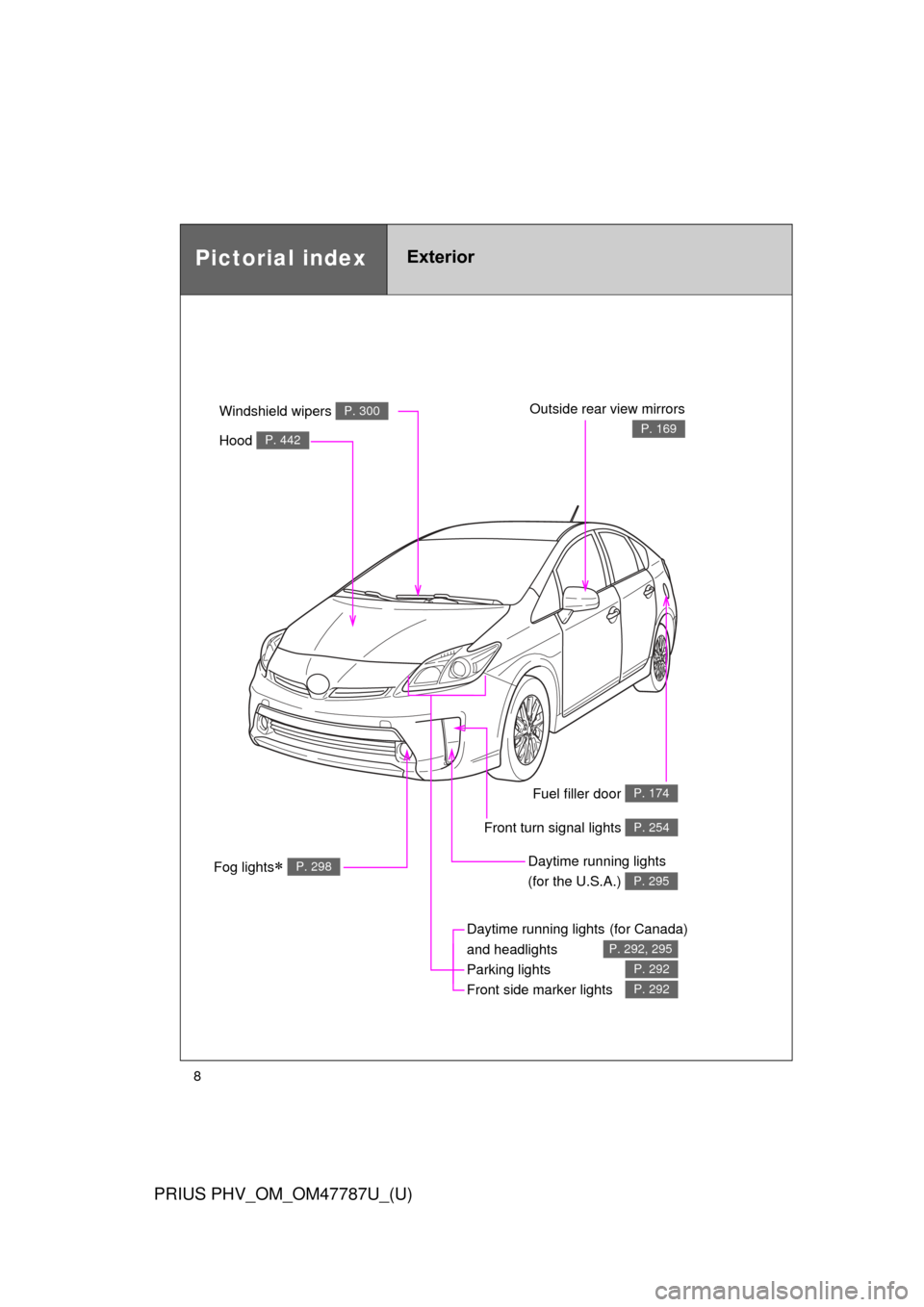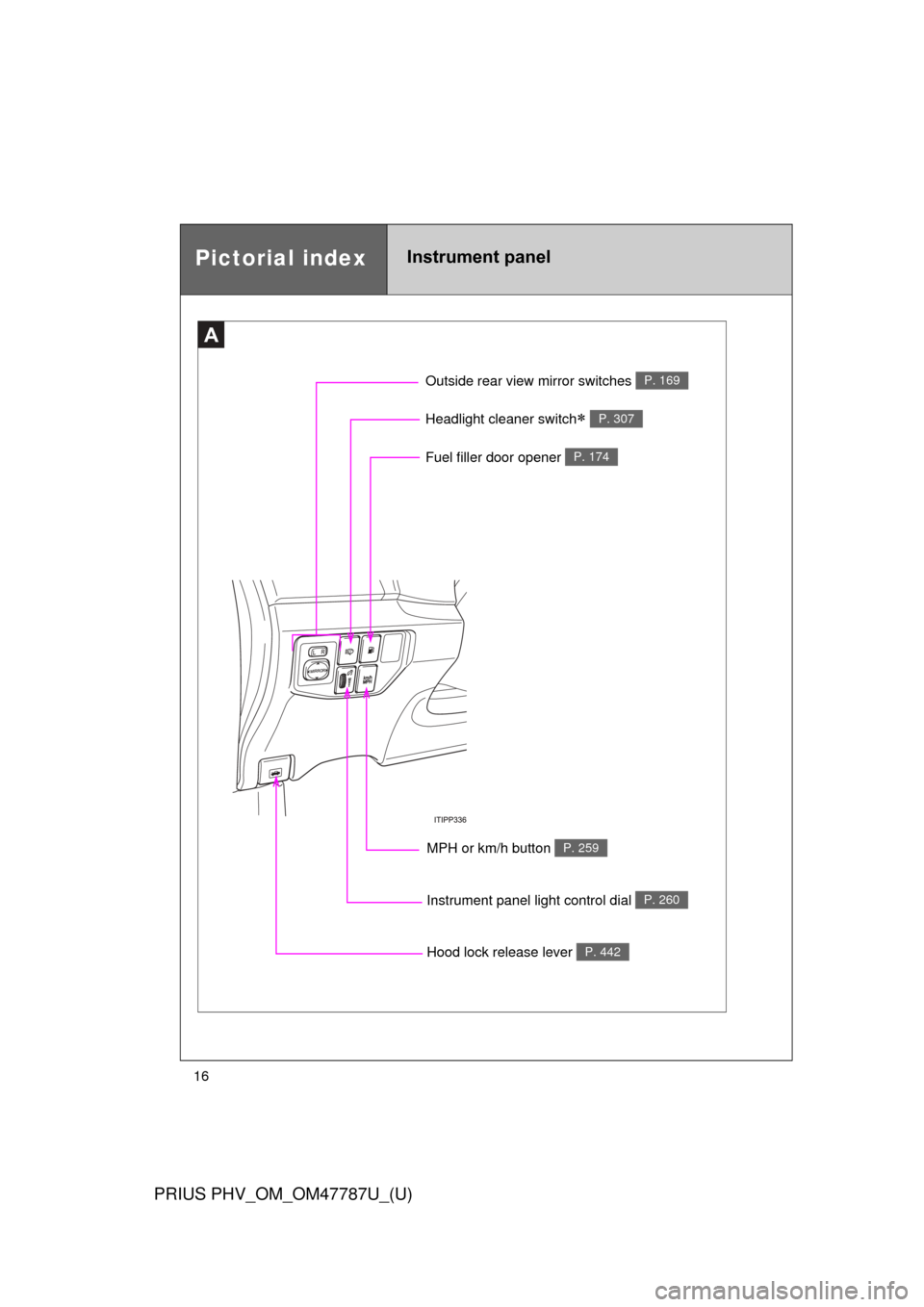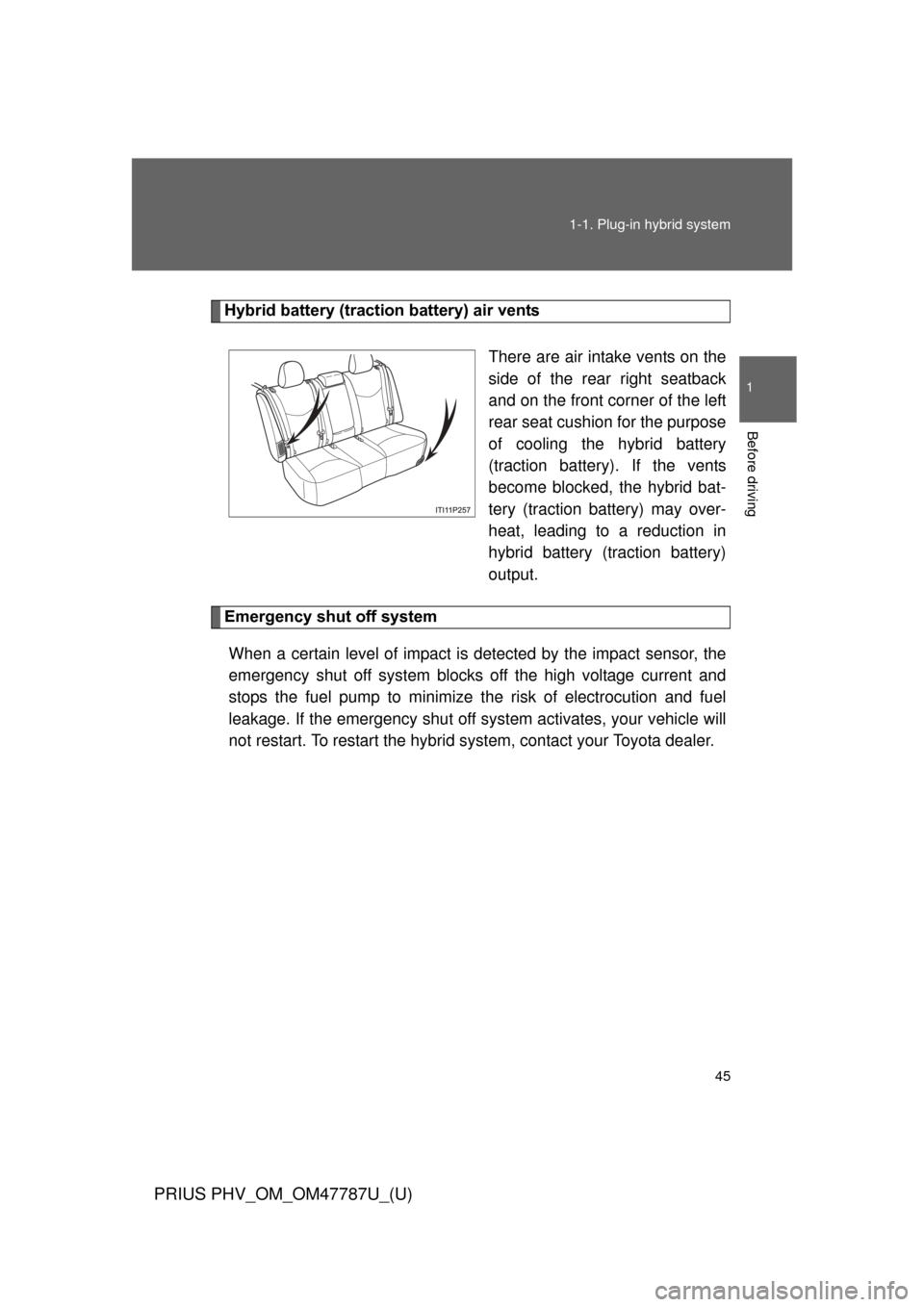fuel TOYOTA PRIUS PLUG-IN HYBRID 2013 1.G Owners Manual
[x] Cancel search | Manufacturer: TOYOTA, Model Year: 2013, Model line: PRIUS PLUG-IN HYBRID, Model: TOYOTA PRIUS PLUG-IN HYBRID 2013 1.GPages: 684, PDF Size: 12.83 MB
Page 2 of 684

TABLE OF CONTENTSIndex
2
PRIUS PHV_OM_OM47787U_(U)
1-1. Plug-in hybrid systemPlug-in hybrid system features .............................. 32
Plug-in hybrid system precautions ........................ 44
Energy monitor/consumption screen ................................ 52
Plug-in hybrid vehicle driving tips .......................... 67
Plug-in Hybrid Applications........................ 70
1-2. Charging Charging equipment ............. 73
Power sources that can be used ................................... 77
How to charge ...................... 80
When normal charging cannot be carried out ......... 98
Inspecting the charging cable ................................ 103
1-3. Key information Keys ................................... 105 1-4. Opening, closing and locking
the doors
Smart key system (with entry function) .......... 108
Smart key system (without entry function) ..... 126
Wireless remote control ...... 132
Side doors .......................... 134
Back door ........................... 140
1-5. Adjustable components (seats, mirrors, steering
wheel)
Front seats.......................... 146
Rear seats .......................... 149
Head restraints ................... 152
Seat belts............................ 156
Steering wheel .................... 165
Inside rear view mirror ........ 166
Outside rear view mirrors ... 169
1-6. Opening and closing the windows
Power windows................... 171
1-7. Refueling Opening the fuel tank cap... 174
1-8. Theft deterrent system Immobilizer system ............. 179
1Before driving
Page 6 of 684

TABLE OF CONTENTSIndex
6
PRIUS PHV_OM_OM47787U_(U)
6-1. SpecificationsMaintenance data (fuel, oil level, etc.) ........... 610
Fuel information ................. 621
Tire information .................. 625
6-2. Customization Customizable features ....... 639
6-3. Initialization Items to initialize................. 647
Reporting safety defects for U.S. owners ..................... 650
Seat belt instructions for Canadian owners
(in French) ........................ 651
SRS airbag instructions for Canadian owners
(in French) ........................ 653 Abbreviation list ............... 666
Alphabetical index ............ 668
What to do if... .................. 680
6Vehicle specifications
7For owners
Index
Page 8 of 684

8
PRIUS PHV_OM_OM47787U_(U)
Fuel filler door P. 174
Pictorial indexExterior
Fog lights P. 298
Daytime running lights(for Canada)
and headlights
Parking lights
Front side marker lights
P. 292, 295
P. 292
P. 292
Hood P. 442
Windshield wipers P. 300Outside rear view mirrors
P. 169
Front turn signal lights P. 254
Daytime running lights
(for the U.S.A.)
P. 295
Page 16 of 684

16
PRIUS PHV_OM_OM47787U_(U)
A
Instrument panel light control dial P. 260
Headlight cleaner switch P. 307
Hood lock release lever P. 442
Outside rear view mirror switches P. 169
Pictorial indexInstrument panel
Fuel filler door opener P. 174
MPH or km/h button P. 259
Page 22 of 684

22
PRIUS PHV_OM_OM47787U_(U)
For your information
Main Owner’s Manual
Please note that this manual applies to all models and explains all equip-
ment, including options. Therefore, you may find some explanations for
equipment not installed on your vehicle.
All specifications provided in this manual are current at the time of printing.
However, because of the Toyota policy of continual product improvement, we
reserve the right to make changes at any time without notice.
Depending on specifications, the vehicle shown in the illustrations may differ
from your vehicle in terms of color and equipment.
Noise from under vehicle after turning off the hybrid system
Approximately five hours after the hybrid system is turned off, you may hear
sound coming from under the vehicle for several minutes. This is the sound
of a fuel evaporation leakage check and, it does not indicate a malfunct\
ion.
Accessories, spare parts and modification of your Toyota
A wide variety of non-genuine spare parts and accessories for Toyota vehi-
cles are currently available in the market. You should know that Toyota does
not warrant these products and is not responsible for their performance,
repair, or replacement, or for any damage they may cause to, or adverse
effect they may have on, your Toyota vehicle.
This vehicle should not be modified with non-genuine Toyota products. Mod-
ification with non-genuine Toyota products could affect its performance,
safety or durability, and may even violate governmental regulations. In addi-
tion, damage or performance problems resulting from the modification may
not be covered under warranty.
Page 23 of 684

23
PRIUS PHV_OM_OM47787U_(U)
Installation of a mobile two-way radio system
The installation of a mobile two-way radio system in your vehicle could affect
electronic systems such as:
●Multiport fuel injection system/sequential multiport fuel injection system
● Cruise control system
● Anti-lock brake system
● SRS airbag system
● Seat belt pretensioner system
Be sure to check with your Toyota dealer for precautionary measures or spe-
cial instructions regarding installation.
High voltage parts and cables on the hybrid vehicles emit approximately the
same amount of electromagnetic waves as the conventional gasoline pow-
ered vehicles or home electronic appliances despite of their electromagnetic
shielding.
Unwanted noise may occur in the reception of the mobile two-way radio.
Page 31 of 684

Before driving1
31
PRIUS PHV_OM_OM47787U_(U)
1-2. ChargingCharging equipment........... 73
Power sources that can be used ................................. 77
How to charge .................... 80
When normal charging cannot be carried out ....... 98
Inspecting the charging cable .............................. 103
1-3. Key information Keys ................................. 105
1-4. Opening, closing and locking the doors
Smart key system (with entry function) ....... 108
Smart key system (without entry
function) ......................... 126
Wireless remote control ... 132
Side doors ........................ 134
Back door ......................... 140 1-5. Adjustable components
(seats, mirrors, steering
wheel)
Front seats ....................... 146
Rear seats........................ 149
Head restraints................. 152
Seat belts ......................... 156
Steering wheel ................. 165
Inside rear view mirror ..... 166
Outside rear view mirrors ............................ 169
1-6. Opening and closing the windows
Power windows ................ 171
1-7. Refueling Opening the fuel tank cap ................................. 174
1-8. Theft deterrent system Immobilizer system .......... 179
1-9. Safety information Correct driving posture..... 182
SRS airbags ..................... 184
Front passenger occupant classification system ...... 198
Child restraint systems..... 204
Installing child restraints... 209
Page 34 of 684

34 1-1. Plug-in hybrid system
PRIUS PHV_OM_OM47787U_(U)
■When in HV mode
The vehicle can be used in the same way as a standard hybrid
vehicle.
In HV mode, controls are primarily carried out as follows in
accordance with the driving conditions.
●The gasoline engine stops when the vehicle is stopped.
● During start off, the electric motor (traction motor) drives the
vehicle.
● During normal driving, the gasoline engine and electric motor
(traction motor) are controlled effectively, and the vehicle is
driven with optimum fuel efficienc y. Also, when necessary, the
electric motor (traction motor) operates as an electrical gener-
ator to charge the hybrid battery (traction battery).
● When the accelerator pedal is depressed heavily, drive force
from both the gasoline engine an d the electric motor (traction
motor) is used to accelerate.
■ When braking (regenerative braking)
The electric motor (traction mo tor) charges the hybrid battery
(traction battery).
The EV driving range can be extended by actively using this
regenerative braking to store el ectricity in the hybrid battery
(traction battery).
Moreover, as fuel consumption is also reduced when in HV
mode, the regenerative braking sy stem can be used effectively.
Page 40 of 684

40 1-1. Plug-in hybrid system
PRIUS PHV_OM_OM47787U_(U)
■Refilling fuel
Plug-in hybrid vehicles can be driven using electricity charged from an exter-
nal power source, however the gasoline engine that is provided on board as
an auxiliary power source and as a power source for driving in HV mode
needs to be filled with fuel. Check the fuel amount and refill immediately
when the fuel level becomes low. ( P. 174)
■ Gasoline engine operation in EV mode
Even if there is a sufficient amount of electricity remaining in the hybrid bat-
tery (traction battery) and EV driving range ( P. 58, 268) is being displayed,
the gasoline engine may operate automatically in the following circum-
stances (EV driving will be returned to automatically after EV driving
becomes possible again):
● When the heater etc. is in use.
● When the temperature of the hybrid system is high.
The vehicle has been left in the sun, driven on a hill, driven at high
speeds, etc.
● When the temperature of the hybrid system is low.
The vehicle has been left in temperatures lower than about 32 °F (0 °C)
for a long period of time etc.
● When power is needed temporarily, for example when accelerating sud-
denly.
● When vehicle speed is more than approximately 62 mph (100 km/h).
● When the accelerator pedal is depressed firmly or the vehicle is on a hill
etc.
● When the outside temperature is low (less than 14 °F [-10 °C])
The gasoline engine may also operate in circumstances other than those
listed above, depending on conditions.
Page 45 of 684

45
1-1. Plug-in hybrid system
1
Before driving
PRIUS PHV_OM_OM47787U_(U)
Hybrid battery (traction battery) air vents
There are air intake vents on the
side of the rear right seatback
and on the front corner of the left
rear seat cushion for the purpose
of cooling the hybrid battery
(traction battery). If the vents
become blocked, the hybrid bat-
tery (traction battery) may over-
heat, leading to a reduction in
hybrid battery (traction battery)
output.
Emergency shut off system When a certain level of impact is detected by the impact sensor, the
emergency shut off syst em blocks off the high voltage current and
stops the fuel pump to minimize t he risk of electrocution and fuel
leakage. If the emergency shut off sy stem activates, your vehicle will
not restart. To restart the hybrid system, contact your Toyota dealer.